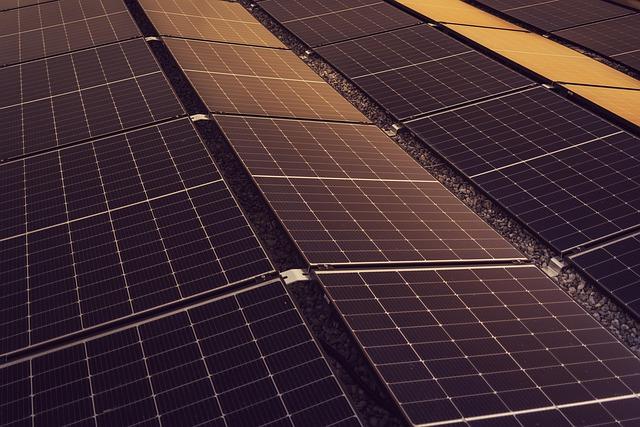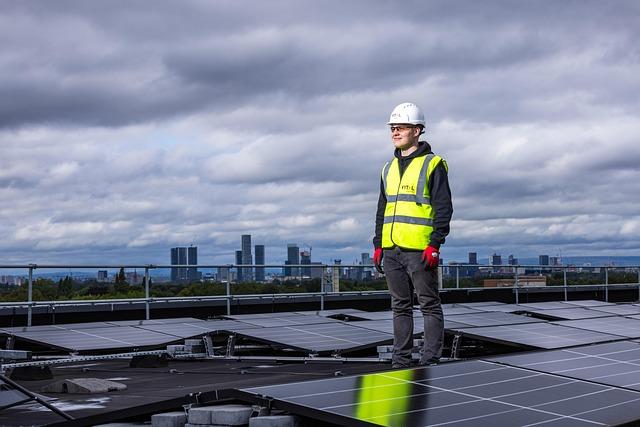Table of Contents
- Understanding the Energy Output of Solar Panels in KWh
- Factors Influencing Solar Panel Efficiency and KWh Production
- Maximizing Your Solar Energy Conversion for Optimal KWh Generation
- The Financial Implications of KWh Production from Solar Panels
- Future Trends in Solar Technology and Their Impact on KWh Performance
- Q&A
- The Way Forward


Understanding the Energy Output of Solar Panels in KWh
Solar panels convert sunlight into electricity, and understanding their energy output is crucial for optimizing usage and ensuring energy efficiency. This output is often measured in kilowatt-hours (kWh), which represents the amount of energy produced over time. The actual kWh generated can vary based on several factors including the panel’s efficiency, the amount of sunlight received, and the installation’s location. Monitoring your solar output over time allows you to track performance and savings effectively.
Several components play a significant role in determining how much energy solar panels produce. Among them are:
- Panel Efficiency: This refers to how well a solar panel converts sunlight into usable energy, with modern panels typically yielding 15% to 22% efficiency.
- Sunlight Hours: The total number of hours that the panels can absorb direct sunlight directly affects kWh output, fluctuating with seasons and geographical location.
- System Size: Larger solar systems, measured in kilowatts (kW), generally produce more energy, so the size of your installation can significantly impact totals.
To provide a clearer understanding, here’s a simple comparison table illustrating the estimated annual kWh output based on different panel sizes and average sunlight hours:
| System Size (kW) | Average Sunlight (hrs/day) | Estimated Output (kWh/year) |
|---|---|---|
| 3 kW | 4 | 4,380 |
| 5 kW | 5 | 7,300 |
| 6 kW | 6 | 10,950 |


Factors Influencing Solar Panel Efficiency and KWh Production
Several aspects play a crucial role in determining the effectiveness of solar panels and their subsequent energy production capabilities. Solar panel technology varies, with monocrystalline, polycrystalline, and thin-film models each showing distinct performance qualities. Monocrystalline panels, for example, typically offer higher energy conversion rates due to their purity and structure, making them suitable for energy-efficient applications in limited spaces. In contrast, polycrystalline panels are slightly less efficient but are often more affordable, providing a balance between cost and performance.
Another significant factor is the angle and orientation of the solar panels. Panels optimized to face south (in the Northern Hemisphere) at a tilt that captures maximum sunlight throughout the day will yield better results. This orientation can enhance annual KWh production by ensuring that panels receive the most direct sunlight possible. Additionally, environmental factors such as shading from trees or buildings can impede energy capture, underscoring the importance of site selection during installation.
Lastly, temperature and weather conditions heavily influence solar panel efficiency. While sunlight is necessary for energy production, extreme heat can actually decrease the output of solar panels. Thus, a balance must be struck where panels are exposed to adequate sunlight while maintaining operational temperatures. To illustrate these factors, the table below outlines how varying conditions impact solar efficiency:
| Condition | Impact on Efficiency (%) |
|---|---|
| Optimal Sunlight | +25% |
| Overheating | -15% |
| Partial Shading | -30% |
| Correct Angle | +20% |


Maximizing Your Solar Energy Conversion for Optimal KWh Generation
To enhance the efficiency of solar panels, understanding the various factors that influence energy conversion is vital. The orientation and angle of your solar panels play a crucial role in maximizing sun exposure. Ideally, panels should be installed at an angle that matches your geographic location to capture sunlight effectively throughout the day. In addition to positioning, shading from trees or buildings can drastically reduce energy production, so it’s advisable to assess your installation area during peak sunlight hours.
Regular maintenance is another key component in boosting energy generation. Keeping the surface of your solar panels clean can prevent dirt and debris from obstructing sunlight. Routine checks for any signs of wear or damage should also be part of your solar energy strategy. Ensuring that the wiring connections are secure and all components, including inverters, are functioning properly will contribute to a consistent kWh output. Simple maintenance practices can make a significant difference in both efficiency and longevity of your solar panels.
In addition to optimal placement and maintenance, leveraging technology can further enhance solar output. Consider investing in a monitoring system that tracks your energy production in real-time. These systems allow you to identify patterns in energy generation and consumption, making it easier to adjust usage habits. By analyzing this data, homeowners can optimize their energy consumption during peak production times, ultimately maximizing the overall value derived from their solar investment.
The Financial Implications of KWh Production from Solar Panels
Understanding involves several factors that contribute to overall energy savings and long-term investment returns. One of the most significant aspects is the decrease in utility bills. By generating your own electricity, homeowners can effectively reduce or even eliminate their monthly energy expenses, leading to substantial savings over time. This financial benefit becomes even more pronounced as utility rates continue to rise, offering an opportunity for solar panel owners to lock in their energy costs.
Another crucial component to consider is the incentives and rebates associated with solar panel installations. Many states and local governments offer attractive financial incentives that can dramatically lower the upfront costs of solar systems. These can include tax credits, grants, and rebates, which allow investors to recoup a portion of their investment quickly. Additionally, the federal solar tax credit allows homeowners to deduct a significant percentage of the installation costs from their federal taxes, further enhancing the appeal of solar energy investments.
To illustrate the economic benefits of solar energy, consider a hypothetical scenario with the following cost analysis:
| Item | Cost (USD) |
|---|---|
| Initial Solar Panel Installation | 15,000 |
| Annual Energy Savings | 1,500 |
| Federal Tax Credit (30%) | 4,500 |
| Net Investment | 10,500 |
| Payback Period (Years) | 7 |
This simplified breakdown shows how an initial investment can be reduced through savings and tax incentives, demonstrating the financial viability of shifting to solar energy. Moreover, increasing awareness about sustainability and climate change has also driven demand for solar energy, fueling growth in property values for homes equipped with solar systems. Thus, the financial implications extend beyond personal savings to positively impact the overall real estate market.


Future Trends in Solar Technology and Their Impact on KWh Performance
The evolution of solar technology is poised to reshape the landscape of renewable energy in significant ways, focusing particularly on enhancing kilowatt-hour (kWh) performance. One of the key advancements is the development of perovskite solar cells, which have demonstrated remarkable efficiency in converting sunlight into electricity. These cells not only promise higher efficiency rates than traditional silicon cells but also offer the potential for reduced manufacturing costs. As perovskite cells continue to mature, they could revolutionize the market, allowing more energy to be produced in less space, thus maximizing output in residential and commercial settings.
Another intriguing trend is the integration of energy storage solutions with solar technology. As battery technology progresses, particularly with innovations in lithium-sulfur and solid-state batteries, solar installations can now store surplus energy generated during the day for use at night or during peak demand hours. This advancement ensures that households and businesses can optimize their energy consumption and minimize reliance on the grid, ultimately improving the overall kWh performance of their solar systems. The combination of efficient solar panels and robust energy storage systems will empower users to maximize their energy independence.
Furthermore, the rise of smart solar technology is transforming how we manage energy consumption. Smart inverters and monitoring systems can analyze production data real-time, providing insights that help users adjust their energy usage patterns. This not only allows for better performance tracking of kWh generation but also aids in optimizing energy use based on consumption habits. As smart technology continues to evolve, it will likely pave the way for a more responsive and efficient solar energy system, where real-time data leads to empowered consumers making informed decisions about their energy consumption.
Q&A
Q&A on Solar Panels kWh: Understanding Energy Output
Q1: What does kWh stand for in relation to solar panels? A: kWh stands for kilowatt-hour, a unit of measurement that indicates the amount of energy produced or consumed over a period of time. When it comes to solar panels, kWh is used to quantify how much electricity the panels generate. This metric is crucial for understanding the efficiency of your solar energy system and assessing savings on your electricity bill.Q2: How is the energy output of a solar panel measured in kWh? A: The energy output is calculated based on the panel’s wattage, the amount of sunlight received, and the duration of exposure to those conditions. For instance, a 300-watt solar panel operating under ideal conditions that receive sunlight for 5 hours will generate approximately 1.5 kWh in that period (300 watts x 5 hours = 1,500 watt-hours, or 1.5 kWh).
Q3: How do I estimate how many kWh my solar panels will generate? A: To estimate your solar output, first look at the wattage of your solar panels, the average daily sunlight hours in your location, and any potential shading issues. Use the formula: kWh = (Wattage of Panels) x (Sunlight Hours) x (Number of Panels) / 1000. This will give you a rough estimate of daily kWh production.
Q4: What factors influence the kWh produced by solar panels? A: Several factors affect the kWh output of solar panels, including:
- Location: Areas with more sunlight will yield higher output.
- Panel Orientation & Tilt: Proper positioning can optimize exposure to sunlight.
- Shading: Trees, buildings, or debris can reduce direct sunlight contact.
- Weather Conditions: Cloud cover, rain, and atmospheric dust can impact efficiency.
- Panel Efficiency: Higher efficiency panels produce more kWh even in low-light conditions.
Q5: How can I maximize the kWh production from my solar panels? A: To maximize the kWh production, consider the following strategies:
- Ensure clean panels, as dirt and grime can obstruct sunlight.
- Position panels strategically to avoid shading throughout the day.
- Monitor and adjust the tilt of panels seasonally based on sunlight variations.
- Consider investing in battery storage systems to store excess energy for later use.
Q6: How does the kWh production of solar panels relate to my energy bills? A: The more energy (kWh) your solar panels produce, the less electricity you need to purchase from your utility provider. This can lead to substantial savings on your bills or even net zero charges, depending on your system size and local energy rates. Keeping track of the kWh produced each month helps you understand your savings and energy independence.
Q7: Are there any specific incentives related to kWh production from solar panels? A: Yes! Many regions offer financial incentives based on kWh production, such as Feed-in Tariffs or performance-based incentives, rewarding homeowners for the electricity they contribute back to the grid. Additionally, tax credits can also be associated with the installation of solar panels, making it even more financially advantageous to maximize production.
Q8: What should I do if my solar panels aren’t producing expected kWh? A: If your solar panels are underperforming, first check for any physical obstructions or dirt on the panels. Ensure that your inverter and other components are functioning correctly. Otherwise, it may be best to consult with a professional solar technician to diagnose potential issues that could be affecting your system’s efficiency.
Understanding the relationship between solar panels and kWh is crucial for harnessing the full potential of solar energy. By knowing how to measure, estimate, and maximize your solar output, you can make informed decisions and enhance your energy independence.



0 Comments